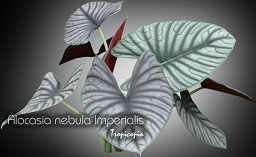Table of contents
Elephant ear

Latin Name: Alocasia nebula Imperialis
Category: Other
Family: Araceae
Origin: Cultivar
Climate: Tropical humid
Growing Zones: 11
Care Instructions
The Elephant ear (Alocasia nebula Imperialis) is a tropical humid plant that originates from Cultivar. This other plant belongs to the Araceae family and is well-suited for growing in USDA zones 11.
Complete Care Guide for Elephant Ear (Alocasia nebula Imperialis)
Watering Requirements
The Elephant Ear, scientifically known as Alocasia nebula Imperialis, thrives in consistently moist soil, making proper watering essential for its health. It is crucial to keep the soil evenly moist but not soggy. Water the plant when the top inch of soil feels dry to the touch. During the growing season, which typically spans from spring to early fall, the plant may require more frequent watering, approximately once or twice a week, depending on the humidity and temperature of its environment. In winter, when the plant enters a dormant phase, reduce watering to allow the soil to dry out slightly between waterings. Always ensure that the pot has drainage holes to prevent waterlogging, which can lead to root rot.
Light Conditions
Elephant Ear plants prefer bright, indirect light to thrive. Direct sunlight can scorch their large, beautiful leaves, so it’s best to place them in a location where they receive filtered light, such as near a window with sheer curtains. If grown outdoors, they should be positioned in a spot that receives dappled sunlight or partial shade, especially during the hottest parts of the day. Insufficient light can lead to leggy growth and smaller leaves, so if you notice these signs, consider relocating your plant to a brighter area. However, be cautious of sudden changes in light exposure, as this can stress the plant.
Soil Preferences
The ideal soil for Elephant Ear plants is a well-draining, rich potting mix that retains moisture without becoming waterlogged. A blend of peat moss, perlite, and compost works well to provide the necessary nutrients and drainage. Aim for a slightly acidic to neutral pH level (around 6.0 to 7.0) for optimal growth. Regular fertilization during the growing season can enhance the plant’s vigor; use a balanced, water-soluble fertilizer every 4-6 weeks. In the fall, reduce fertilization as the plant prepares for dormancy. Additionally, consider repotting every couple of years to refresh the soil and provide more space for growth.
Pests and Diseases
While Elephant Ear plants are generally hardy, they can be susceptible to a few common pests and diseases. Watch for aphids, spider mites, and mealybugs, which can cause damage by sucking sap from the leaves. Regularly inspect the undersides of leaves and treat infestations promptly with insecticidal soap or neem oil. Fungal diseases, such as root rot and leaf spot, can occur if the plant is overwatered or if humidity levels are too high. Ensure proper air circulation and avoid wetting the leaves during watering to minimize these risks. If you notice yellowing leaves or a foul smell from the soil, it may indicate root rot, necessitating immediate action to save the plant.
Special Care Tips
To keep your Elephant Ear plant healthy and thriving, consider the following special care tips. First, maintain a humid environment, as these tropical plants flourish in high humidity. You can increase humidity by misting the leaves regularly, using a pebble tray filled with water, or placing a humidifier nearby. Additionally, during the growing season, consider rotating the plant every few weeks to ensure even light exposure on all sides, promoting balanced growth. If you live in a region with cold winters, it’s advisable to bring your Elephant Ear indoors to protect it from frost. Lastly, be cautious when handling the plant, as its sap can be irritating to the skin; wearing gloves is recommended during repotting or pruning.








